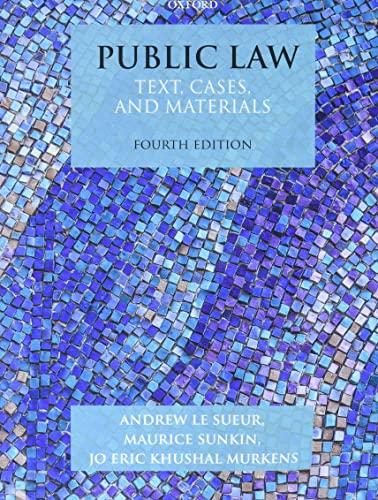Question
1. Plaintiff 2. Defendant 3. Causes of action 4. Civil or criminal/how do you know? 5. Federal or state/how do you know? 6. Types of
1. Plaintiff
2. Defendant
3. Causes of action
4. Civil or criminal/how do you know?
5. Federal or state/how do you know?
6. Types of damages
English professor said his firing was a breach of contract
In September 2011, William Crenshaw, a tenured English professor, was terminated by defendant Erskine College after 35 years of employment. Crenshaw filed suit in Abbeville County Court of Common Pleas in South Carolina against Erskine College and its president, David A. Norman, alleging breach of contract, wrongful termination and intentional infliction of emotional distress. Crenshaw argued there was no cause to terminate him and that he was not afforded due process rights under his employment contract. The termination occurred in response to a medical emergency suffered by a student in Crenshaw's class. According to Crenshaw, who had served as a paramedic, a female student became ill and showed signs of a concussion. He informed the dean that she should call an ambulance. His instructions to call an ambulance allegedly triggered tensions in the college, as the college's athletic trainers argued that Crenshaw should have called them to the scene, rather than an ambulance. As a result, the college claimed Crenshaw violated procedures and policies of the college, which resulted in his termination. In response, Crenshaw maintained that he had taken reasonable measures to help a student and that calling an ambulance was not an adequate cause to fire him. The college denied any contractual violations. The defense argued that Crenshaw violated the procedures and policies of the college by not utilizing its athletic training staff to treat the student. Moreover, the defense contended that the college had just cause to fire Crenshaw and followed proper procedures to do so.
Crenshaw sought damages for lost wages and benefits. He maintained that he was unable to find another teaching position and that he attempted to mitigate his damages. The defense contended that Crenshaw was properly terminated and that no damages were due or owing. Further, the defense argued that Crenshaw could have found other employment and failed to mitigate his damages.
The jury found that the plaintiff did not violate his obligations under his employment contract and that the defendant violated its employment agreement with Crenshaw. The jury determined that the plaintiff's damages totaled $600,000.
Step by Step Solution
There are 3 Steps involved in it
Step: 1

Get Instant Access to Expert-Tailored Solutions
See step-by-step solutions with expert insights and AI powered tools for academic success
Step: 2

Step: 3

Ace Your Homework with AI
Get the answers you need in no time with our AI-driven, step-by-step assistance
Get Started


